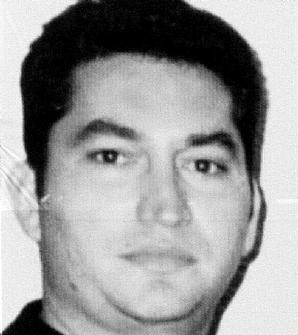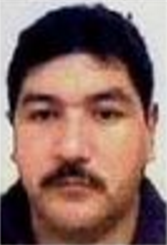
Coahuila, formally Coahuila de Zaragoza, officially the Free and Sovereign State of Coahuila de Zaragoza, is one of the 32 states of Mexico.

Tamaulipas, officially the Free and Sovereign State of Tamaulipas, is a state in Mexico; one of the 31 states which, along with Mexico City, comprise the 32 Federal Entities of Mexico. It is divided into 43 municipalities.

Los Zetas is a Mexican criminal syndicate and terrorist organization, known as one of the most dangerous of Mexico's drug cartels. They are known for engaging in brutally violent "shock and awe" tactics such as beheadings, torture, and indiscriminate murder. While primarily concerned with drug trafficking, the organization also runs profitable sex and gun rackets. Los Zetas also operate through protection rackets, assassinations, extortion, kidnappings and other illegal activities. The organization is based in Nuevo Laredo, Tamaulipas, directly across the border from Laredo, Texas. The origins of Los Zetas date back to the late 1990s, when commandos of the Mexican Army deserted their ranks and began working as the enforcement arm of the Gulf Cartel. In February 2010, Los Zetas broke away and formed their own criminal organization, rivalling the Gulf Cartel.

Humberto Moreira Valdés is a Mexican politician who served as President of the Institutional Revolutionary Party. He was Governor of the State of Coahuila from 2005 to 2011.

Jorge Eduardo Costilla Sánchez is a former Mexican drug lord and top leader of the criminal drug trafficking organization known as the Gulf Cartel. He was among Mexico's most-wanted drug lords, until his arrest in 2012.

Miguel Ángel Treviño Morales, commonly referred to by his alias Z-40, is a Mexican former drug lord and leader of the criminal organization known as Los Zetas. Considered a violent, resentful and dangerous criminal, he was one of Mexico's most-wanted drug lords until his arrest in July 2013.
The Federal Social Readaptation Center No. 1 "Altiplano" is a maximum security federal prison of the Secretariat of Public Security in Mexico. It was originally called the Penal de Máxima Seguridad No. 1 "Almoloya de Juárez", later renamed the Federal Social Readaptation Center No. 1 "La Palma", before assuming its present name. This facility is located in the Santa Juana Centro neighborhood of Almoloya de Juárez, in the State of Mexico, 25 kilometers (16 mi) from Toluca.

Heriberto Lazcano Lazcano, commonly referred to by his aliases Z-3 and El Lazca, was a Mexican drug lord and the leader of Los Zetas drug cartel. He was one of the most-wanted Mexican drug lords.

La Familia Michoacana, La Familia, is a Mexican drug cartel and organized crime syndicate based in the Mexican state of Michoacán. They are known to produce large amounts of methamphetamine in clandestine laboratories in Michoacan. Formerly allied to the Gulf Cartel—as part of Los Zetas—it split off in 2006. The cartel was founded by Carlos Rosales Mendoza, a close associate of Osiel Cárdenas. The second leader, Nazario Moreno González, known as El Más Loco, preached his organization's divine right to eliminate enemies. He carried a "bible" of his own sayings and insisted that his army of traffickers and hitmen avoid using the narcotics they produce and sell. Nazario Moreno's partners were José de Jesús Méndez Vargas, Servando Gómez Martínez and Enrique Plancarte Solís, each of whom has a bounty of $2 million for his capture, and were contesting the control of the organization.

Nazario Moreno González, commonly referred to by his alias El Chayo and/or El Más Loco, was a Mexican drug lord who headed La Familia Michoacana before heading the Knights Templar Cartel, a drug cartel headquartered in the state of Michoacán. He was one of Mexico's most-wanted drug lords.
Óscar Omar Treviño Morales is a Mexican convicted drug lord and former leader of Los Zetas, a criminal organization. He was one of Mexico's most-wanted drug lords. His brother is Miguel Treviño Morales, a former leader of the group. The authorities believe he was the successor of his brother, who was arrested on July 15, 2013.

Jesús Enrique Rejón Aguilar is a former leader of the Mexican criminal organization known as Los Zetas. He was wanted by the governments of Mexico and USA until his capture on July 4, 2011 in Atizapán de Zaragoza, a Mexico City suburb.
This is a list of Mexico's 37 most-wanted drug lords as published by Mexican federal authorities on 23 March 2009. According to a BBC Mundo Mexico report, the 37 drug lords "have jeopardized Mexico national security."

Iván Velázquez Caballero, also known by his alias El Talibán, is a Mexican convicted drug lord of the criminal group known as Los Zetas. The government of Mexico listed Velázquez Caballero in 2009 as one of its 37 most-wanted drug lords and was offering up to $30 million pesos, the equivalent of over $2.5 million USD, for information leading to his capture.

Mario Armando Ramírez Treviño, commonly referred to by his aliases El Pelón and/or X-20, is a Mexican suspected drug lord and former leader of the Gulf Cartel, a drug trafficking organization.

Miguel Villarreal was a U.S.-born Mexican suspected drug lord and high-ranking leader of the Gulf Cartel, a criminal group based in Tamaulipas. He was the crime boss of Reynosa, Tamaulipas. Nicknamed El Gringo in reference to his U.S. nationality, Villarreal was identified by authorities as a Gulf Cartel leader in 2010, when he allegedly commanded cells that fought Los Zetas drug cartel in northeastern Mexico. By 2011, he served as the regional kingpin in Miguel Alemán, Tamaulipas and ordered several kidnappings and killings in the South Texas border area from Mexico.

Jorge Luis Mendoza Cárdenas, commonly referred to by his alias La Garra, is a Mexican suspected drug lord and high-ranking leader of the Jalisco New Generation Cartel (CJNG), a criminal group based in Jalisco. Security forces suspect that La Garra heads the drug trafficking operations for the CJNG in the United States under Nemesio Oseguera Cervantes, the top leader of the criminal group. La Garra reportedly coordinates marijuana, cocaine, heroin, and methamphetamine shipments to Los Angeles, San Jose, Atlanta, and New York City from Mexico.

Carlos Landín Martínez, also known as El Puma, was a Mexican former police chief and convicted drug lord. He was a high-ranking member of the Gulf Cartel, a criminal group based in Tamaulipas, Mexico, and worked as the second-in-command of the cartel in Reynosa from 2005 to 2007. Landín Martínez was a trusted enforcer of the kingpin Gregorio Sauceda Gamboa. Among his responsibilities included managing international drug trafficking shipments from Tamaulipas to Texas, collecting taxes from independent traffickers who operated in his turf, and managing money laundering operations. Landín Martínez was also a commander in the Tamaulipas State Police, where he headed the homicide taskforce. According to a witness who testified against him in court, Landín Martínez worked for the Gulf Cartel while still employed by the state police.

Alfonso Lam Liu, also known as Gordo Lam, is a Mexican convicted drug lord and former high-ranking member of the Gulf Cartel, a criminal group based in Tamaulipas, Mexico. Lam Liu was part of the cartel during the early 2000s and worked as the regional leader of Río Bravo under the directorship of Jorge Eduardo Costilla Sánchez and Osiel Cárdenas Guillén. As head of organized crime activities in Río Bravo, Lam Liu was responsible for coordinating international cocaine and marijuana trafficking shipments to the U.S. and of smuggling drug proceeds back into Mexico. During his tenure, Lam Liu worked closely with local government officials, who helped facilitate the Gulf Cartel's operations in exchange for bribery payments.

Gilberto Barragán Balderas is a Mexican suspected drug lord and high-ranking member of the Gulf Cartel, a criminal group based in Tamaulipas, Mexico. He joined the cartel in the late 1990s and was a trusted enforcer of kingpin Jorge Eduardo Costilla Sánchez. Barragán Balderas was the regional boss of Miguel Alemán and helped coordinate international drug trafficking shipments from South and Central America to Mexico and the U.S. His role in the cartel also included providing them with information on the movement and location of Mexican security forces to ensure safe passage of their cocaine and marijuana shipments. In 2008, an indictment issued by the U.S. District Court for the District of Columbia detailing his criminal activities was unsealed in court.



















